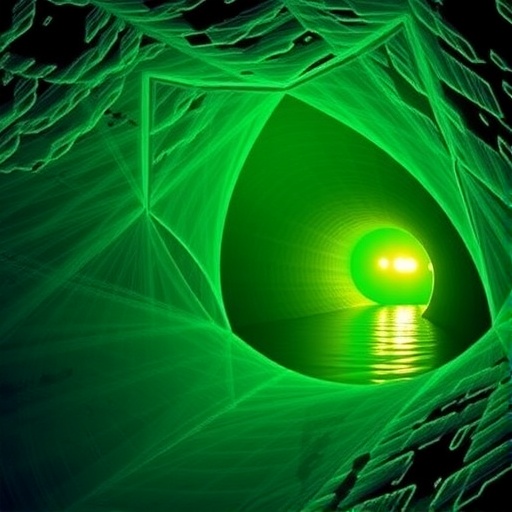Deep beneath the surface of Shanghai’s bustling cityscape lies a remarkable feat of engineering: the Shanghai Outer Ring Tunnel, a vehicle passage weaving silently under the Huangpu River. This underwater conduit serves as an essential artery for urban transport, yet its very nature presents daunting challenges for upkeep and safety. Conventional inspection and maintenance methods necessitate disruptive shutdowns or intrusive procedures, both costly and risky. However, a team of innovative researchers has recently harnessed an extraordinary tool from particle physics—muography—to unveil the hidden sediment deposits clinging to the tunnel’s structure without ever breaching its confines.
Muography, a cutting-edge imaging technique, capitalizes on naturally occurring muons—high-energy subatomic particles born from cosmic ray interactions in the upper atmosphere. These muons possess an uncanny ability to traverse substantial depths of earth and rock, making them invaluable probes of subterranean environments. By quantifying changes in the flux of muons passing through materials of varying density, scientists can reconstruct detailed maps of concealed structures within the Earth. The research collective in Shanghai embarked on an ambitious pilot project applying muography to monitor sediment accumulation along this vital subaqueous tunnel, a pioneering application destined to redefine infrastructure diagnostics.
The core principle hinges on the differing densities between water and sediment materials such as mucky soil and silty clay, which tend to settle and accumulate around underwater structures. This sediment, denser than water, attenuates muon flux more effectively, creating detectable fluctuations. Deploying a state-of-the-art portable muon flux detection system inside the tunnel, researchers measured these variations in situ. Their assembly could discern subtle differences in density distribution by analyzing the energy losses muons incur through ionization interactions—processes where muons eject electrons from atoms in traversed material. Denser sections cause greater muon depletion, providing a physical signature of sediment thickness.
Dr. Kim Siang Khaw, lead author of the study, elucidates the physics underpinning the method: “Muons primarily lose energy via ionization—the denser the material, the higher the frequency of electromagnetic interactions that lead to electron ejections from atomic structures. Sediments comprised of fine granular particles or clay amplify this attenuation.” This relationship forms the basis of a non-invasive geological tomography, offering a real-time window into underground deposition patterns that had previously eluded precise monitoring.
The research team executed a meticulous spatial survey over the entire tunnel length, pausing at intervals of 50 meters to collect muon data for approximately 10 minutes per station. Supplementing empirical observations with computational simulations replicating muon trajectories through a simplified tunnel model, they painstakingly mapped sediment layer thickness with unprecedented spatial resolution. While this initial trial emphasized proof-of-concept, plans are underway to install a network of fixed muon detectors throughout the tunnel, enabling continuous, remote sediment surveillance—a transformative approach that promises to bolster maintenance strategies and hazard prevention for underwater infrastructure.
Envisioning broader horizons, investigators anticipate expanding muographic sediment monitoring to multiple other tunnels throughout Shanghai’s extensive transport network. What makes this technique remarkably accessible is its minimal dependence on complex prior models. Instead, it leverages fundamental tunnel geometries, baseline environmental parameters, and initial muon flux references—parameters that are often readily available or straightforward to gather. This combination of simplicity and sensitivity opens avenues for global urban centers to adopt muography as an innovative standard for subterranean infrastructure health assessment.
Beyond sediment accumulation, the researchers highlight the technique’s capacity to detect perilous underground voids—an insidious threat arising from burst pipes or soil erosion, which can precipitate catastrophic tunnel collapses if left undetected. Muography’s ability to reveal these cavernous anomalies stems from the characteristic muon flux enhancements where density abruptly decreases, thus illuminating potential hazards before they manifest catastrophically. This early-warning functionality embodies a critical leap in civil engineering safety protocols.
Muography’s heritage spans diverse domains—from exploring the enigmatic interiors of ancient pyramids to mapping mineral deposits in active mines. However, its translation into a dynamic monitoring tool for changing subterranean conditions marks a novel and timely frontier. Tracking temporal variations in muon flux and tying them to structural changes not only deepens scientific understanding but tangibly addresses pressing societal needs. This confluence of fundamental particle physics and applied engineering exemplifies the innovative spirit driving 21st-century infrastructure resilience.
“In this remarkable era for muography, we are venturing beyond static imagery into continuous, adaptive monitoring of vital underground systems,” remarked Khaw. “Collaborating with engineers, urban planners, and fellow scientists, we aim to harness these insights to safeguard communities worldwide.” As cities continue to grow vertically and horizontally, embedding such revolutionary technology into infrastructure management protocols offers a blueprint for sustainability and safety in increasingly complex urban landscapes.
The implications stretch far beyond Shanghai’s waterways. Anywhere muons penetrate—beneath mountains, beneath oceans, or beneath urban sprawl—this technique offers unprecedented, non-invasive access to hidden geological phenomena otherwise obscured from routine inspection. The Shanghai Outer Ring Tunnel pilot heralds a transformational moment, validating muography’s versatility and robustness for real-world infrastructure monitoring, potentially setting a global standard across civil, environmental, and geological engineering fields.
This pioneering study, titled “Toward noninvasive sediment monitoring using muography: A pilot run at the Shanghai Outer Ring Tunnel,” presents both the conceptual framework and experimental verification of a revolutionary non-destructive evaluation method. Published in the Journal of Applied Physics on September 16, 2025, it represents a milestone at the intersection of particle physics and applied civil engineering, offering a compelling new lens through which humanity can visualize, understand, and manage our hidden built environments.
Subject of Research: Muography-based noninvasive sediment monitoring in underwater tunnel infrastructure
Article Title: Toward noninvasive sediment monitoring using muography: A pilot run at the Shanghai Outer Ring Tunnel
News Publication Date: September 16, 2025
Web References:
https://doi.org/10.1063/5.0273686
https://pubs.aip.org/aip/jap
References:
Khaw et al., “Toward noninvasive sediment monitoring using muography: A pilot run at the Shanghai Outer Ring Tunnel,” Journal of Applied Physics, 16-Sep-2025.
Image Credits: Khaw et al.
Keywords
Muons, Particle physics, Subatomic particles, Physics, Civil engineering




